- Green Card USA
- What is a Green Card?
What is a Green Card?
A Green Card entitles its holder to permanently live and work in the USA. As an official ID document, the popular immigrant visa also gives the Green Card owner almost all the rights of a US citizen.
- Definition of the Green Card
- Green Card: US immigration made easy
- The history of the Green Card
- What does a Green Card look like?
- The advantages of a Green Card
- How do I get a Green Card?
- How much is a Green Card?
- How to apply for a Green Card?
- Apply for a family-based Green Card
- Apply for an employment-based Green Card
- Apply for an investment-based Green Card
- Winning a Green Card in the Green Card Lottery
- Do Green Card holders have to immigrate?
- Green Card as an ID
- How long is a Green Card valid?
- Green Card renewal
- Become a US citizen with a Green Card
- Can I buy a Green Card?
- Living in the USA without a Green Card
Take the chance of living in the USA and apply for the official US Green Card Lottery!
Definition of the Green Card
The US Green Card is officially called Lawful Permanent Resident Card or Form I-551. Anyone who obtains the highly sought-after US immigrant visa - whether through the Green Card Lottery or one of the alternative application processes - is granted unrestricted work and residence authorization for the United States of America.
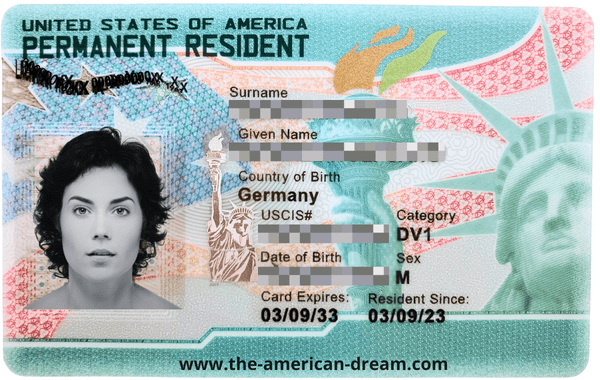
This is what the current US Green Card looks like.
When communicating with the issuing authority, U.S. Citizenship and Immigration Services (USCIS), a new Green Card candidate is initially called "Applicant" or "Beneficiary". Lawful holders of a Green Card are also referred to as "Lawful Permanent Residents" or "LPR".
After a successful Green Card application process, the Green Card enables USA fans to freely choose their place of work and residence, to enter and leave the country easily, to study in the USA at a much lower cost, and to acquire additional benefits after a few years as a Green Card holder.
Green Card: US immigration made easy
Unlike other US visas, the Green Card is the only sustainable way to move to America. This is due to the lifetime validity of a Lawful Permanent Residence.
Although you can also live and work in the USA for some time with temporary work visas, the expiration date of your US visa poses a permanent risk.
The history of the Green Card
The USA has always been an immigration country par excellence. During the 19th and early 20th centuries, immigration to the United States was still unregulated - America was open to immigrants from anywhere in the world in unlimited numbers.
After the American Civil War, the U.S. Supreme Court introduced the first innovations. Later, the "U.S. Immigration and Naturalization Service" (INS for short) was established in 1933.
The foundation for today's Green Card was laid during World War II: In 1940, the US Congress passed the Alien Registration Act, which established the first concrete rules for immigrating to the United States.
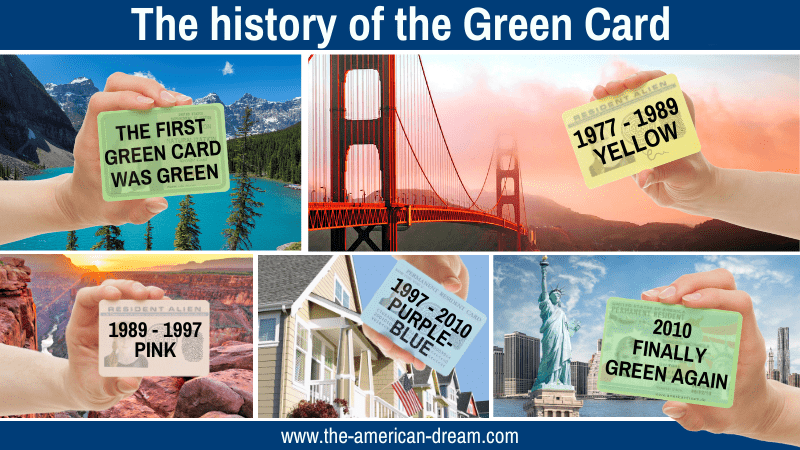
One of the first decisions was to inspect all immigrants entering the United States and issue them an ID card. The document issued was then called "Alien Card" or "Alien Registration Receipt Card" and was actually bright green. This is how the nickname “Green Card" came about.
In 2003, U.S. Immigration and Naturalization Service (INS) was renamed "U.S. Citizenship and Immigration Services." USCIS still issues the Green Cards today.
After the Green Card was produced in changing colors for a few years (first yellow, then pink, then purple-blue), the US government decided in 2010 to go back to a green design.
What does a Green Card look like?
The modern US Green Card contains the following elements or data:
- Surname
- Given name
- USCIS number
USCIS numbers are uniquely assigned sequential numbers. - Category
The visa category describes the way you received your Green Card, e.g. "DV1" for the Green Card Lottery or "CR1" for conditional residents, whose Green Card is subject to a time limit. - Country of birth
- Date of birth
- Sex
- Expiration date
- Issue date
- Photo of the Green Card holder
- Hologram
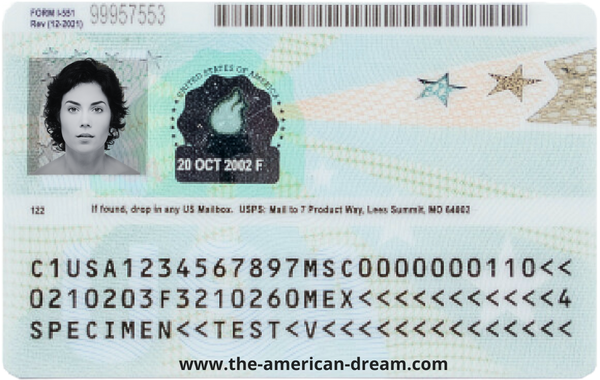
Back of a GreenCard
On the back of the Green Card you can find:
- A barcode
- Another photo of the Green Card holder
- A three-line machine-readable code (as on a passport)
With the latest changes to increase the security of the Green Card, the following changes have been made:
- New image technology
- Motif changes (e.g., Statue of Liberty)
- New tactile printing
- Improved optically variable ink
- Highly secure holographic images on the front and back
- Fingerprint removal on the front
- A layer reveal feature with a partial window on the back photo box
- Data fields in a modified order
The advantages of a Green Card
Owning a US Green Card gives its holder nearly all rights equal to those of a US citizen. These include:
- Unlimited residency in the US
- Unlimited work permit in the USA
- Unlimited and easy entry and exit without a visa or ESTA
- Eligibility for Medicare benefits and other government assistance after 5 years as a Green Card holder
- The right to study at a US university without risk and up to 80 % cheaper than without a Green Card
- The possibility of federal loans for students
- Crisis security: Green Card holders are usually not affected by travel embargoes.
- Uncomplicated obtaining of business and commercial licenses
- Family members (spouses and unmarried children under 21) are automatically eligible for a Green Card as well.
- Application for US citizenship is possible after 3 or 5 years as a Green Card holder.
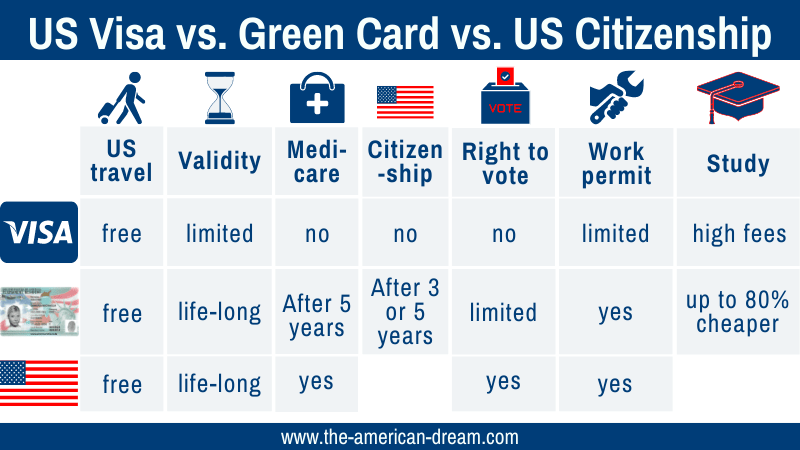
How do I get a Green Card?
The US Green Card can only be obtained:
- Through a job in the USA
- For a family reunion with US relatives
- By winning the Green Card Lottery
- Through a large investment in a US company
For most people, the Green Card Lottery is the only chance to live a carefree life in America, because it is very difficult for foreigners to get a permanent job in the USA.
In the Green Card Lottery, the US authorities raffle 55,000 Green Cards worldwide every year. The chances of winning are excellent, but many participants are eliminated from the lottery because they do not submit their applications precisely in the specified format. Even the smallest errors will result in disqualification by US authorities.
Another problem is that a disqualified Green Card applicant is not informed by the US government that he or she has been disqualified - let alone why. As a result, many Green Card Lottery participants make the same mistakes year after year and don't even realize it.
For this reason, it is recommended to consult an expert. With The American Dream's government-licensed immigration consultants, Green Card applicants are protected from disqualification thanks to the double application review and personalized assistance service.
How much is a Green Card?
Depending on your individual journey to the Green Card, the cost of the US immigrant visa differs.
Unlike the straightforward Green Card Lottery with only the basic costs, employment-based and family-based Green Cards come with additional costs due to the need for evidence and affidavits. Expect the following costs:
| Basic Green Card costs | |
|---|---|
| Processing Fee | $ 625 - $ 715 |
| USCIS Immigrant Fee | $ 235 |
| Biometrics Services Fee (photo and fingerprints) |
$ 30 |
| Medical examination (by a medical professional for the immigration process) |
$ 400 - $ 700 |
| Employment-based Green Card: Additional costs | |
| Immigrant Petition for Foreign Workers | $ 715 |
| Attorney and/or agency fees for a Labor Certification | vary between $ 3,000 and $ 4,000 |
| Premium Processing Fee to shorten wait times, some of which can be years long |
$ 2,805 |
| Family-based Green Card: Additional costs | |
| Foreign Relative Petition Fee | Paper Filing: $ 675 Online Filing: $ 625 |
You also need to consider the cost of a Green Card activation trip to the USA. These do not apply, however, if you have chosen the SMART or VIP tariff from The American Dream. Here, the costs for your outbound and return flight to the USA are covered in full.
How to apply for a Green Card?
If you are dreaming of living in America, first explore your options:
- Do you have relatives in the United States?
- Do you have special skills that could make you invaluable to an employer in the United States?
- Do you meet the eligibility requirements for the Green Card Lottery?
If you answer "yes" to one or more of these questions, then nothing will get in your way (except the paperwork, of course).
Apply for a family-based Green Card
Family reunifications through Green Cards are especially useful for spouses and children of US citizens since in most other constellations (such as Green Cards for siblings) there are long waiting periods.
If you are a spouse, an unmarried child under the age of 21, or a parent of a US citizen at least 21 years old, then you belong to a so-called "Immediate" category and theoretically have no waiting periods. In practice, however, you will not receive your Green Card until after a processing time of 5 - 18 months (or 3 - 12 months in the case of children).
Unmarried children over the age of 21, as well as married children and siblings of a US citizen (who is 21 or older), can also apply for a Green Card, but they have to expect much longer waiting periods.
Family members of Green Card holders
If your family member living in the US is "only" a Lawful Permanent Resident, but not a US citizen, then you belong to the second preference category as a dependent and have to expect waiting periods.
The processing time for a family-based Green Card varies from case to case and can range from a few months to up to 15 years.
Apply for an employment-based Green Card
Due to the strict burden of proof and high costs for US employers, obtaining a Green Card through the workplace is hard and relatively rare. Those who still wish to go through the application process for a work-based Green Card must choose one of the five categories:
|
EB-1A |
Extraordinary Ability |
|
EB-1B |
Outstanding Professors and Researchers, Managers and Executives |
|
EB-2 |
Advanced Degree, Exceptional Ability |
|
EB-3 |
Skilled Workers, Professionals, Other Workers |
|
EB-4 |
Special Immigrants and Religious Workers |
|
EB-5 |
Investors |
The classification into the five preference categories already gives an indication that waiting times of varying lengths will occur. In many cases, these waiting times can be avoided with an expensive process acceleration ("Premium Processing").
Unfortunately, obtaining the required Labor Certification is also time-consuming and expensive. This certificate proves that the job for which a foreign employee is to receive the Green Card cannot be filled by a US citizen instead.
Apply for an investment-based Green Card
With a large financial investment in a US company, it is possible to acquire a Green Card. The minimum amount for this is $ 800,000 in rural or economically weak regions. In all other cases, $ 1,050,000 is required.
The EB-5 visa issued here is equivalent to a Green Card on probation. After two years (if all requirements are met), the residency status is adjusted upon application and the investor becomes a Lawful Permanent Resident.
Winning a Green Card in the Green Card Lottery
The Green Card Lottery (also called the DV Lottery or Diversity Visa Lottery) is the easiest way for most people to get a Green Card.
With its very low entry requirements, the lottery brings 55,000 participants from around the world to the US every year.
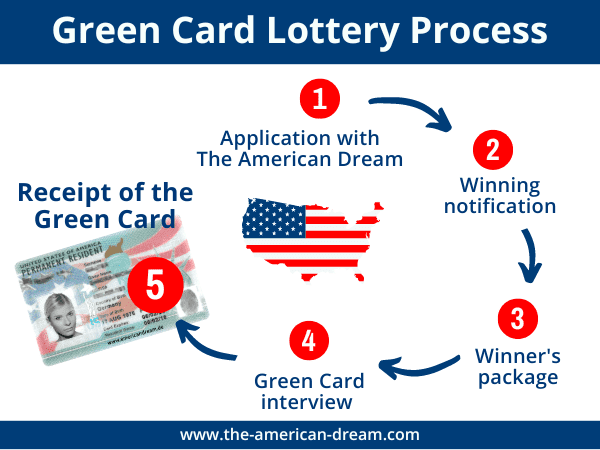
Do Green Card holders have to immigrate?
The purpose of the Green Card is for a person to permanently relocate their center of life to the USA. However, when the American dream suddenly comes true, there are many things to do. The US authorities have an understanding of this and give Green Card winners enough time to shift their lives to the United States bit by bit.
Especially in the first few years, commuting between the US and the home country is usually not a problem. However, as a Green Card holder, you must keep in mind that you are not allowed to stay outside the USA for more than 12 months (or 24 months upon application) at a time - otherwise your Green Card rights may be taken away from you.
Most Green Card winners decide to relocate permanently after four to five years at the latest.
Green Card as an ID
The many benefits and rights of a Green Card holder are opposed by one obligation: when in the United States, you must carry your Green Card with you at all times.
The physical Green Card proves that you are a Lawful Permanent Resident. Therefore, if your Green Card is lost, stolen, or destroyed, it is important to get it replaced.
You will need to show your Green Card frequently in your everyday American life, for example, when opening a bank account, obtaining your American driver's license, or applying for a job.
Note: Under Section 264(e) of the Immigration and Nationality Act (INA), you may be fined up to $ 100 if you are caught without your Green Card. In cases of hardship, you may even face 30 days in jail.
How long is a Green Card valid?
If you are a Lawful Permanent Resident, then your residence and work permit for the USA is valid for life. Nevertheless, the physical Green Card as an identity document only has a term of ten years and must be renewed in time.
You must initiate the renewal process no later than 6 months prior to the expiration of the Green Card via USCIS Form I-90.
Note: The validity of your physical Green Card has nothing to do with your status as a legal US resident.
There are circumstances that may cause your Green Card validity to expire. These are, for example:
- Being outside the US for more than 364 days at a time without prior application
- Becoming a US citizen
- Returning your Green Card to a US consulate or USCIS Service Center (including official return documents)
- Committing serious criminal acts
- Missing revocation deadlines (e.g. on conditional Green Cards for newly married immigrants or investors)
- Violating immigration law
Green Card renewal
After applying for a replacement or renewal of a Green Card via Form I-90, you will be sent a so-called "I-797" Notice of Action. You must carry this document with you as proof of your lawful residency status in the US until you receive your new Green Card.
Learn more about how to renew your Green Card.
Become a US citizen with a Green Card
Green Card holders can qualify for US citizenship after five years. If you are married to a US citizen, you only have to wait three years. The basic requirements for naturalization to the US include:
- A minimum of 30 months spent in the US within the last five years (or 18 months within three years if married to a US citizen)
- Residence in the same state or county for at least three months prior to applying
- Respect for the United States Constitution (as well as no violations of the law)
- Sufficient English skills and knowledge of American history and government
View all documents for the US naturalization process at https://www.uscis.gov.
Can I buy a Green Card?
Buying a Green Card is rather literal. Green Cards acquired by investing in US companies are temporary Green Cards tied to strengthening the US economy and creating jobs.
Shortly before the end of the first two years, these so-called EB-5 Green Cards can be converted from conditional Permanent Resident Status to unlimited Lawful Permanent Resident Status.
Living in the USA without a Green Card
Living in the USA without a Green Card is possible, but mostly dominated by deadlines, hurdles, additional costs, and financial difficulties. Even with a legitimate work visa, which can theoretically be extended, there is always the risk of losing everything.
Only with a Green Card, life in the United States can really be planned. If you want a permanent job, a driver's license, your own houses, or a loan, your Green Card is the door opener.
Even in times of crisis, when temporary visas are simply often not renewed and aid money is only paid to US citizens and Green Card holders, you are on the safe side as an LPR.
If you participate in the Green Card Lottery once a year, you have done everything you can to win a Green Card.
Try your luck with The American Dream - better safe than sorry!

uscis.gov, travel.state.gov

 DE
DE EN
EN ES
ES FR
FR IT
IT PL
PL TR
TR UA
UA